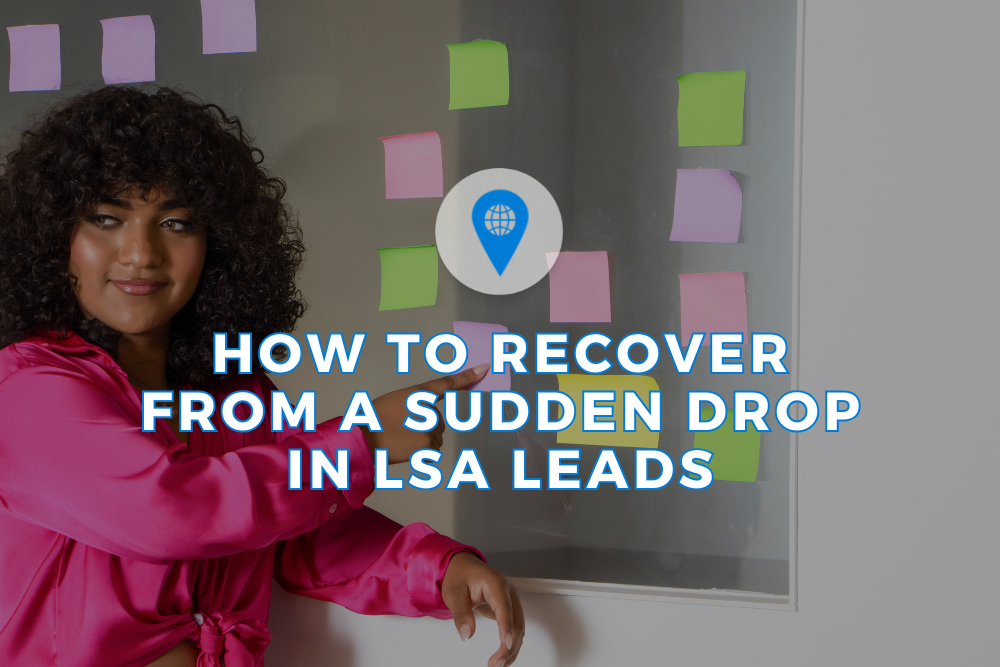How to Recover from a Sudden Drop in LSA Leads
- Published: September 29, 2025

You’ve been generating consistent leads through Google Local Services Ads (LSAs), and then—almost overnight—the momentum disappears. Calls slow down, messages stop, and your visibility plummets.
If your LSA performance suddenly drops, you’re not alone. Lead declines can happen for a variety of reasons: algorithm shifts, account issues, missed leads, or changes in your service profile. The good news? Most issues are recoverable once you identify the cause and respond quickly.
This guide walks you through the most common reasons for LSA performance drops and provides a clear roadmap to recovery.
Step 1: Rule Out the Basics
Start with a quick audit of common technical or setup-related issues:
- Is your ad active?
Visit your LSA dashboard to confirm your ads are running. Ads may pause automatically when budgets are exhausted or when documents expire. - Did you hit your monthly budget cap?
Even if it’s early in the month, your ads will pause once your monthly spend limit is reached. Adjust your budget to match expected lead flow. - Are your business hours correct?
Google will not show your ads outside of your listed business hours unless you have 24/7 availability. Ensure your hours reflect when you’re able to accept leads.
Step 2: Analyze Your Lead History
Your lead dashboard can provide valuable context:
- Review the trend of incoming leads over the past two to four weeks
- Check the volume of leads you’re disputing (excessive disputes may hurt performance)
- Identify any leads marked as unanswered or unbooked
- Confirm that your active job types and service areas are still aligned with demand
Look for any correlation between a drop in leads and recent changes you may have made.
Step 3: Evaluate Your Profile Health
Google rewards complete, active, and high-performing LSA profiles. A decline in any of these areas can impact your rankings and lead volume.
Review performance factors such as:
Reviews
- Are you consistently collecting new reviews?
- Have you recently received multiple negative reviews?
- Were any reviews flagged or removed?
Responsiveness
- Are you answering leads quickly, especially within the first 15 minutes?
- Are you marking leads as “booked” or engaging with them through the dashboard?
Profile Accuracy
- Did you make changes to job types or ZIP code coverage that narrowed your audience??Are your photos, business bio, and certifications up to date?
Step 4: Investigate Silent Suspensions or Document Expirations
Google may quietly pause or suppress your LSA account for reasons that don’t always appear obvious.
Check the following:
- Expired licenses or insurance documents
- Mismatched contact details between your Google Business Profile and your LSA account
- New employees or field workers who haven’t completed background checks
- Missing identity or business verification updates
In your dashboard, look for language such as “Business not verified” or “Pending review”—these often indicate backend issues.
Step 5: Evaluate Market Conditions and Algorithm Changes
If your profile appears healthy, the drop may be external. Ask the following:
- Has there been a seasonal decline in demand?
- Have more competitors in your area joined LSA recently?
- Did Google make changes to ad rotation, policy, or ranking factors?
- Are other providers in your vertical reporting similar drops?
Tools like Google Trends and local keyword trackers can help validate whether demand has truly shifted.
Step 6: Rebuild Momentum
Once you identify the issue, take targeted action to restore performance.
Focus on the following:
Generate New Reviews
- Follow up with recent customers and request Google reviews
- Emphasize specific service types or outcomes to improve keyword relevance
Adjust Job Types and Service Areas
- Reintroduce any high-performing services you may have paused
- Expand to additional ZIP codes or suburbs if your current areas are slow
Improve Responsiveness
- Set up call forwarding or an answering service to capture leads after hours
- Assign team members to monitor LSA messages and calls during peak times
Increase Budget Strategically
- If demand is high, temporarily increase your daily or monthly budget to stay competitive
- Monitor for budget exhaustion early in the day or week
Optimize Your Profile
- Refresh your business bio with updated services and specialties
- Add high-quality photos that reflect seasonal or urgent work
- Double-check your licenses and insurance documentation for expiration dates
Step 7: Escalate to Google Support (If Necessary)
If you suspect your profile is being suppressed without a clear reason—or you need to dispute a support decision—reach out directly to LSA support.
Provide documentation such as:
- Screenshots of lead history
- Active license and insurance files
- Review history
- A list of disputed leads with reasons
- Evidence of responsiveness and service completion
Working with an LSA-certified partner like Local View can also speed up escalations and help resolve complex cases more effectively.
Avoiding Future Drops: Ongoing Best Practices
To protect against future performance dips:
- Maintain a steady stream of recent reviews
- Keep business documents updated in advance
- Monitor lead trends weekly and adjust budgets accordingly
- Maintain high responsiveness rates, especially on weekends and holidays
- Avoid excessive lead disputes unless clearly justified
- Audit your job types and ZIP codes quarterly
Conclusion: Drops Are Fixable—But Require Action
A sudden drop in Google LSA leads doesn’t mean your campaign is dead—it means something has changed. The fastest recoveries happen when businesses respond quickly, optimize proactively, and communicate with Google when needed.
At Local View, we’ve helped hundreds of local businesses identify the exact reason behind sudden LSA drops and recover performance within days—not weeks.
